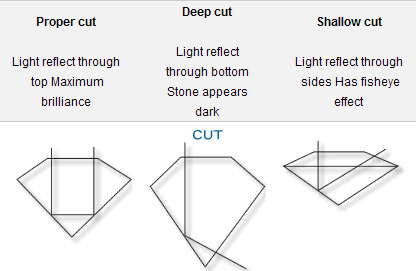Diamond Education: Learn the 4Cs before you Shop
For first-time buyers, shopping for diamond engagement rings or other diamond jewelry can get overwhelming. Before you begin, learn the basics with the 4Cs: color, clarity, cut and carat weight from Joseph Schubach Jewelers
There are four main factors that determine the quality - and therefore the cost - of a diamond:
- Color, which refers to the amount of body color a diamond has.
- Clarity, or purity, refers to the amount of inclusions or imperfections in a diamond.
- Cut refers to the type and quality of the diamond's cut, which determines how light is reflected by the diamond and affects its overall brilliance.
- Carat refers to how much a diamond weighs.
These factors, known as the 4Cs, will determine your diamond's beauty and value. Learn more about the 4Cs below so you can shop for diamond jewelry with confidence.
There are many unique terms jewelers and others in the diamond industry use regarding the cuts and properties of diamonds. If you want to learn more, we’ve created a glossary of diamond industry terms.
Color

Color refers to the amount of body color a diamond has, most commonly yellow or brown, but also rarely in pink, green, blue, orange, and fancy yellow. The color of a diamond is an important characteristic because it is noticeable to the untrained eye.
Generally, the "whiter" a diamond appears, the more desirable it is - and therefore costlier. While D is considered colorless, most diamonds through the I color range will appear colorless when worn.
Clarity

Inclusions or imperfections in a diamond reduce its clarity, lowering a diamond's value. Inclusions can be white spots, black spots, feathers, cracks or included crystals. A diamond's clarity is graded using the following scale:
- FL - Flawless. No inclusions found under 10-power magnification.
- VVS1-VVS2 - Very, very slightly included. Very minor pinpoints only visible under magnification, so minute that it will take upwards of 30-40 minutes for a trained professional to locate using a microscope.
- VS1-2 - Very slightly included. Easier to find under magnification, but completely eye clean. May consist of a minute feather, minute black or white marks, or very faint clusters of inclusions.
- SI1-2 - Slightly included. Easy to locate under magnification. May include feathers, black or white marks, clusters, fractures, etc. but still only visible under magnification (some larger SI2 graded stones may have a very slight inclusion visible to the unaided eye).
- I1-I3 - Imperfect. Inclusions visible to the unaided eye. May include feathers, black or white marks, clusters, fractures, etc. Diamonds in the I2-I3 range usually have inclusions that affect the structural durability of the diamond, as well as lowering the diamond's brilliance.
Generally, diamonds with an accurately graded clarity of SI1 or SI2 and higher will have no inclusions visible to the naked eye - looking identical to a flawless diamond. Diamonds with I1-3 will have inclusions visible to the eye without magnification.
Cut

The way a diamond is proportioned, or cut, determines how it reflects light and affects its overall brilliance. A diamond's cut is one of the most important factors to consider when buying a diamond.
A properly cut diamond will be bright and lively to the unaided and untrained eye, while an improperly cut one will lose much of its sparkle. Diamond proportions may account for as much as 25 percent of a diamond's price.
A properly cut diamond will also be well-proportioned and have the correct diameter for its carat weight in its setting, while an improperly cut diamond will show a different diameter size:
Properly Cut Diamond
- 1ct - 6.5mm diameter
- ¾ct - 6mm diameter
Improperly Cut
- 1ct - 5.8mm diameter
- ¾ct - 5.2mm diameter
A poorly cut 1ct diamond may look smaller than it is because it has the diameter of a ¾ct diamond that's been cut properly. The weight can be distributed to the diamond's pavilion (or bottom), to the girdle (center) or to the crown (top), where the weight has no benefit because in most diamond jewelry, such as diamond engagement rings or diamond stud earrings, it is not seen. The smaller, properly cut diamond will cost less and be more brilliant than its larger, poorly cut counterpart.
Carat Weight
The last "C" refers to how much a diamond weighs (in carats). The chart below shows approximate diameters for properly cut diamonds in different carat weights. Because larger crystals are rarer than smaller crystals, diamond pricing increases exponentially with the increase in diamond weight. For example, a 1ct diamond is more than twice the amount of two ½ct diamonds.

For more information on diamond grading, visit the Gemological Institute of America (GIA)